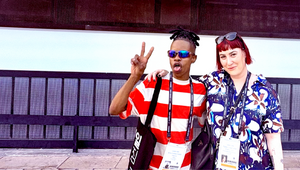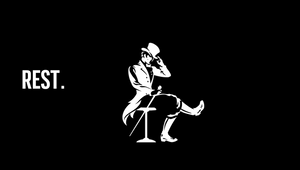
5 Minutes with… Carl Willoughby

Carl Willoughby has been a steady fixture on the South African advertising scene for over 20 years. Now chief creative officer at TBWA\Hunt\Lascaris in Johannesburg, he’s honed his creative sensibilities working on wide-ranging brands from BMW to Liberty, Standard Bank to Jameson – even launching a telecommunications company during a stint in the Middle East.
Focused on developing work that he dubs “locally relevant yet globally competitive,” Carl’s projects have been recognised at major award shows, both locally (Loeries, Bookmark Awards) and internationally (Cannes Lions, One Show, D&AD). In his past two and a half years at TBWA\Hunt\Lascaris, he’s also helped the agency achieve titles including Cannes Lions Regional Network of the Year and Overall Agency of the Year at The Creative Circle, where he is serving as a chairperson. He also sits on the board of the Loerie Awards.
LBB’s Zara Naseer caught up with Carl to drill down on his inspirations and aspirations, his observations on South African advertising, and the hardships that have made him a stronger CCO.
LBB> How did you end up in this career? Were there clues when you were growing up?
Carl> I had highly academic aspirations but I didn’t have the marks to back it up to be honest. I grew up in the Marvel/DC world and I guess my love for comics got me into copying them by recreating my favourite characters. At the time it helped me focus on one skill that would later open up the doorway to this crazy world of creativity that I really still love.
LBB> Who are your creative heroes and why?
Carl> At the time, storyboard artists inspired me. But as I became more familiar with this world, people like John Hunt, Graham Warsop, and Alistair King all inspired me. I’m lucky to still have access to John which is an incredible privilege. I’ve always said I’m a John groupie, now I get to be mentored by him. Besides John, I’ve also found inspiration with people like Sir John Hegarty, David Droga (whose trajectory in this world is actually insane, still), Anselmo Ramos, Björk, Jonathan Glazer, Nadav Kander, Nabil Elderkin, Romain Gavras.
LBB> You’ve previously mentioned that you take pride in developing work that is “locally relevant yet globally competitive” – have you found that the two qualities are often in tension with one another?
Carl> South Africa is home to so many different cultures with multiple languages. Our work has to resonate with our diverse audiences. I believe the goal is to create work that resonates, that is relevant, yet creatively distinctive. We unfortunately often over-index on work that resonates but doesn’t move the creative standard forward. I really think that is a comfortable trap that has led to a lot of the ‘sameness’ within our work.
Our cultural diversity should be a strength to celebrate, but it shouldn’t be restrictive. There are multiple similar markets to ours around the world where highly creative work is made that is tailored to a specific audience. We shouldn’t lose sight of the fact that our work, no matter the relevance, needs to be distinctive. Our jobs fundamentally rely on being noticed. You cannot stand out by getting lost in a sea of cultural sameness.
I see so much work that celebrates local insights but the standard of the work is pretty poor. I find it incredibly disheartening that there are brands in our local market that think an insight is an idea. It’s not – it should help lead to an idea. But sadly, I’m seeing lots and lots of locally relevant insights used to create very average work. That is sad.
LBB> How has the South African advertising scene most notably changed across your time in it?
Carl> I’ve really interrogated this and I believe we’re a nation of great storytellers. We’ve told great stories in the more traditional media spaces. But, as the industry shifted, as our cultural needs shifted in a more liberated post-apartheid era, our ability to compete in more contemporary media spaces has lagged – and I feel it’s held us back. Don’t get me wrong, many agencies in South Africa have developed some incredible non-traditional work, including our agency, but we just generally struggle with some key aspects that will help us show up globally.
LBB> What makes that scene unique today, and why should the global advertising community pay attention to it?
Carl> We’re so diverse, and we’re unique in many ways. We’ve got heart, we’re passionate. We had Trevor Noah, Tyla, we’ve got the Springboks (don’t hate me but they are still the world champs). We have so many incredible skills. Our talent is in high demand. I think if we managed to get outside our bubble we could realise just how much potential we have and how much we can achieve.
LBB> You’ve had a decorated career so far, but aside from the awards, what are you most proud of?
Carl> When our work connects as intended with the right audience. Whether it’s on big brands or smaller initiatives, seeing the work working gives me immense joy.
LBB> On the flip side, have you undergone any specific hardships in your career that have now made you a stronger CCO? What did you learn from them?
Carl> I’ve worked with people who made me feel that I wasn’t good enough. I reached a point in my career where I felt I needed to consider my exit strategy – I even developed a strong passion for photography as a result. But honestly, once one positive thing happened it led to more successes. In the end it’s hard work and commitment that makes all the difference.
It’s helped me identify two key traits within the hiring process: talent and drive. While I appreciate talent, for me it means nothing without drive. You need to want it, you need a chip on your shoulder, you need to want success to survive in this game. It’s a brutal industry that is currently shifting in a seismic way – you really need drive to overcome the obstacles. To quote Zig Ziglar, “there’s no elevator to success, you have to take the stairs.”
LBB> What are your most exciting plans for TBWA\Hunt\Lascaris?
Carl> I wish there was one silver bullet, but in my experience there isn’t. Getting Hunt Lascaris to where we want to be takes so much work, in so many different spaces. We’re innovating, we now have an innovation lead, we’re pushing our younger talent; I believe that’s where the ideas we’re looking for will come from. We’re trying different ways into the work, different processes that just shake things up. We’re empowering our staff, we’re building stronger client relationships. We’re profiling the work as much as we can and leveraging our network more to help give us more objectivity with our work. So my answer includes everything we do on the daily, as it all influences the one thing that matters most, that we all cannot do without: it’s the work.
LBB> Outside of work, what's inspiring you right now?
Carl> We’ve got some incredible things happening in the creative space. You’ll know about more established artists like Tyla, Black Coffee, but we’ve also got so many interesting things happening with fashion designers like Thebe Magugu, Max Xhosa. A fine artist (whom I’m connected to) to watch out for is Felix Shumba, who’s doing some interesting work and exhibiting in the international space.







